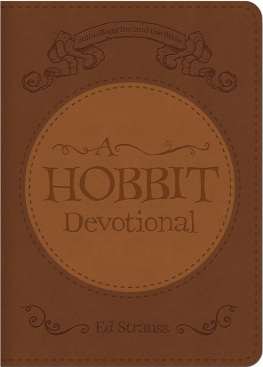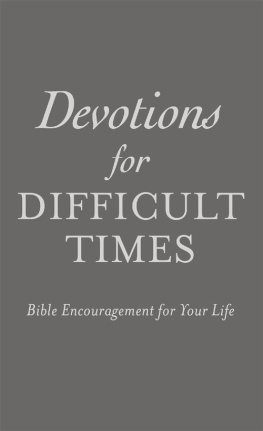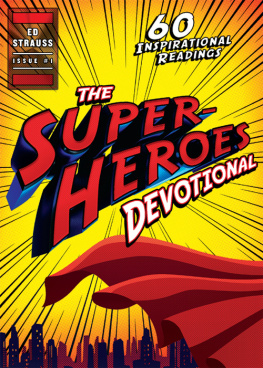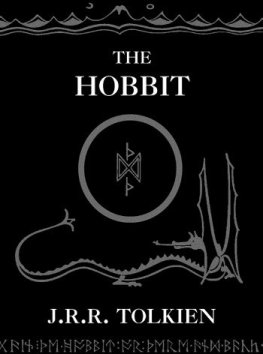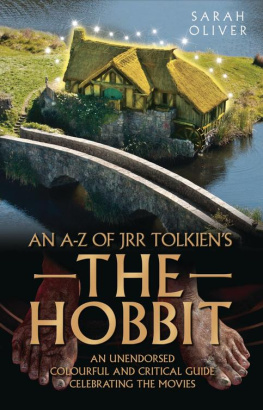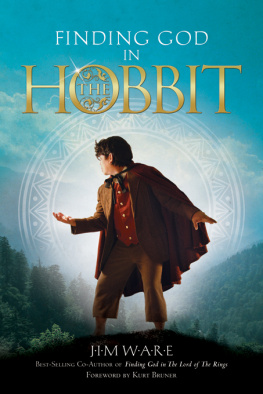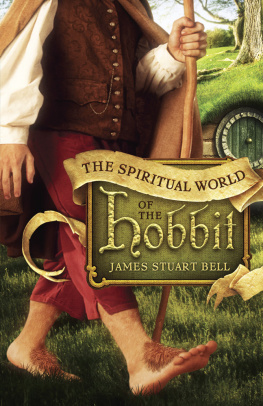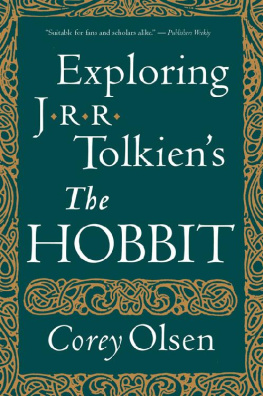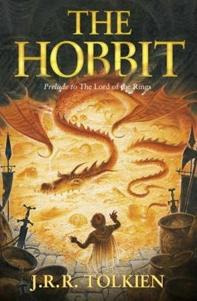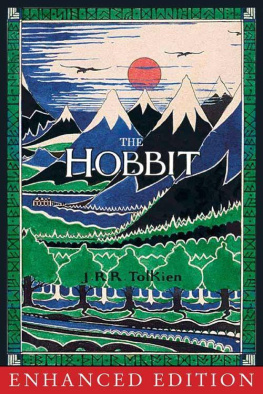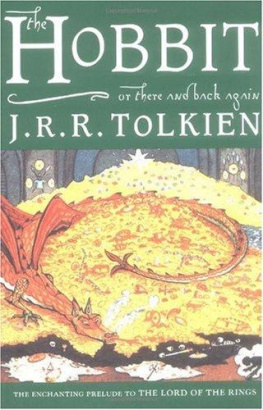
A
Hobbit
Devotional
Ed Strauss

2012 by Ed Strauss
Print ISBN 978-1-63058-490-0
eBook Editions:
Adobe Digital Edition (.epub) 978-1-63058-977-6
All rights reserved. No part of this publication may be reproduced or transmitted for commercial purposes, except for brief quotations in printed reviews, without written permission of the publisher.
Churches and other noncommercial interests may reproduce portions of this book without the express written permission of Barbour Publishing, provided that the text does not exceed 500 words and that the text is not material quoted from another publisher. When reproducing text from this book, include the following credit line: From A Hobbit Devotional, published by Barbour Publishing, Inc. Used by permission.
Scripture quotations marked NIV are taken from the HOLY BIBLE, NEW INTERNATIONAL VERSION, NIV . Copyright 1973, 1978, 1984, 2011 by Biblica, Inc. Used by permission. All rights reserved worldwide.
Scripture quotations marked NKJV are taken from the New King James Version. Copyright 1982 by Thomas Nelson, Inc. Used by permission. All rights reserved.
Scripture quotations marked NLT are taken from the Holy Bible. New Living Translation copyright 1996, 2004, 2007 by Tyndale House Foundation. Used by permission of Tyndale House Publishers, Inc. Carol Stream, Illinois 60188. All rights reserved.
Scripture quotations marked KJV are taken from the King James Version of the Bible.
Original Cover design by Kirk DouPonce, DogEared Design
Published by Shiloh Run Press, an imprint of Barbour Publishing, Inc., P.O. Box 719, Uhrichsville, Ohio 44683 www.barbourbooks.com
Our mission is to publish and distribute inspirational products offering exceptional value and biblical encouragement to the masses.

Introduction:
The Heart of The Hobbit
J.R.R. Tolkien wrote The Hobbit as a childrens story, and its bumbling, lighthearted humor mingled with frightful images and grim realism made it an instant classic when it appeared in 1937. When his publisher urged him to write a sequel, Tolkien set out to do just that, writing the first chapter that same year. But what slowly emerged from the deep wells of his imagination was not another childrens tale, but a mature story with a complex plot structure. Written in epic style, set against the sweeping panorama of Middle-earth, Tolkien created The Lord of the Rings.
The Hobbit is most definitely the prequel to The Lord of the Rings. In fact, in the latter Frodo picks up the adventure precisely where his uncle Bilbo left off in The Hobbit. Yet the stylistic divideand the difference in attention to detailsis so pronounced that if you try to compare the two books you might be told, Remember, The Hobbit is a childrens story! For some, a simpler book cant be taken as seriously as The Lord of the Rings.
This is, I believe, a mistake. Despite its differences in style, The Hobbit contains just as many serious scenes; the dangers it describes are just as real; and the struggles its characters endure are just as pronounced. And although The Hobbit starts off humorously, deeper and darker themes begin to emerge quickly, almost completely dominating the story. Tolkien noted that the tone and style change with the Hobbits development, passing from fairy-tale to the noble and high. In addition, profound emotions such as fear, insecurity, loneliness, hopelessness, and despair are prevalentrelentlessly sothroughout the story, which finally culminates in a terrific clash of armies as desperate as the Battle of the Pelennor Fields.
Nevertheless, many people who read The Lord of the Rings (or see the movies) before reading The Hobbit are surprised by its more whimsical tone and characterizations. Tolkien was aware of this issue and in 1960 began to rewrite The Hobbit as a more formal, epic novel. After writing the first three chapters, however, he abandoned the project, realizing that much of the rapid pacing and charm of his original story was being lost. He therefore decided on only a few revisions, leaving the story mainly as he had written it.
In The Hobbit Tolkien repeatedly shows Bilbo and the dwarves overcoming fear with courage, discouragement with tenacity, and despair with hope. Because we today also face constant challengesin our finances, our careers, and our personal liveswe can draw encouragement from this story. I therefore invite you to take a long, deep look with me into the heart of The Hobbit.
ED STRAUSS
AUGUST 2011
1
Out of Our Comfort Zones
In a hole in the ground there lived a hobbit.... It was a hobbit hole, and that means comfort.
THE HOBBIT, CHAPTER 1
A very long time agoso J.R.R. Tolkien tells usa small, happy people called hobbits lived in a comfortable corner of Middle-earth known as the Shire.
Bilbo Baggins was one of the most comfort-loving hobbits of all. He came from a respectable, well-to-do family and enjoyed the luxury of a hobbit hole inside a hill featuring several bedrooms, washrooms, kitchens, dining rooms, and wardrobes. Like all hobbits, Bilbo Baggins ate six meals a day when he could get themand he usually could.
Now, most hobbits didnt experience quite as much luxury as Bilbo, but they still filled their dwellings with as many comforts and conveniences as they could. Hobbits worked hard to get such things, but they were accustomed to plenty in their pleasant, good land.
Like the hobbits, we in the modern West are quite prosperous compared with most others in the world. We have to work hard for our good things, truebut our work is generally rewarded: Our homes are comfortable and modern, and we eat good food, wear fashionable clothes, and enjoy quite a few luxuries beyond our actual needs.
Its great to live in a land of peace and plenty. And theres nothing wrong with enjoying our comforts and conveniences like big-screen TVs and all the latest gadgets. But being surrounded by material things can create a problem for us. It did for the hobbits.
As Tolkien tells us, the hobbits became so comfortable and self-absorbed that they paid less and less attention to what was happening in the lands around them until they came to think that peace and plenty were the rule in Middle-earth.
Of course, that wasnt how things were. Much of Middle-earth was falling into desperate times. A dark lord named Sauron (under the guise of the Necromancer) was entrenched in his stronghold in Mirkwood and beginning to mobilize armies of orcs. In the ancient land of Eriador, trolls were descending from their mountain haunts and devouring whole villages. East of the Misty Mountains, goblins and wargs were plotting to wipe out entire settlements of men. Goblin armies were brooding in Gundabad and would soon attempt to overrun the North. And there was Smaug the dragon.
But the hobbits, comfortably sheltered in the Shire, neither knew nor cared about the rest of the world.
Over four thousand years ago, some Israelites had a similar blind spot. The Canaanite warlord of Hazor had conquered the northern half of their country and oppressed them for twenty years. Then a soldier named Barakurged by the judge Deborahcalled the Israelites to rise up and fight. Tribes like Zebulun and Naphtali rushed into combat and fought heroically, risking their lives in the deadliest parts of the battlefield, but tribes like Reuben and Dan and Asher didnt even show. They sat around campfires watching their flocks or remained on the seacoast, loading their ships. Apparently, the Canaanites werent
Next page
